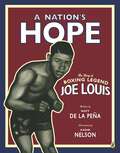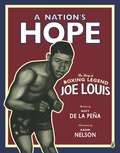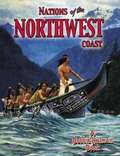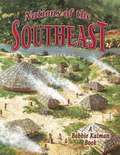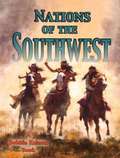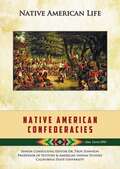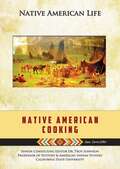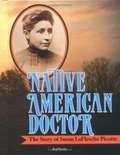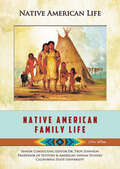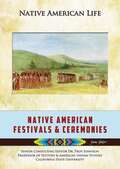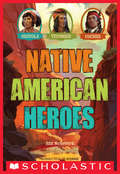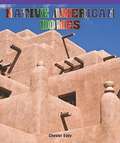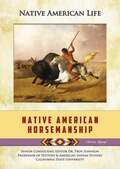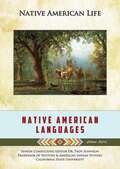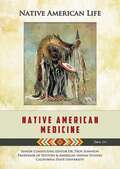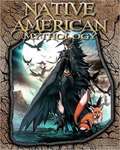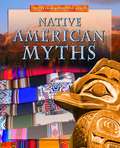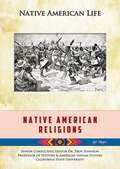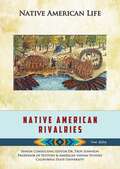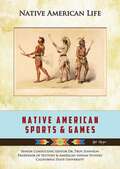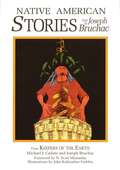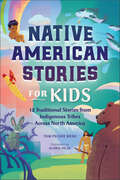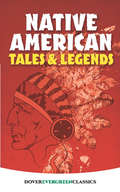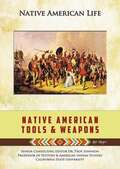- Table View
- List View
A Nation's Hope: The Story of Boxing Legend Joe Louis
by Matt de la PeñaOn the eve of World War II, African American boxer Joe Louis fought German Max Schmeling in a bout that had more at stake than just the world heavyweight title; for much of America their fight came to represent America's war with Germany. This elegant and powerful picture book biography centers around the historic fight in which Black and White America were able to put aside prejudice and come together to celebrate our nation's ideals.
A Nation's Hope: The Story Of Boxing Legend Joe Louis
by Matt de la PeñaThe magnificent, inspiring story of an AMERICAN SPORTS HERO On the eve of World War II, African-American boxer Joe Louis fought German Max Schmeling in a bout that had more at stake than just the world heavyweight title. <P><P>For much of America, their fight came to represent America’s war with Germany. This elegant and powerful picture book biography centers on this historic fight in which the American people came together to celebrate our nation’s founding ideals.
Nations Of The Northwest Coast
by Bobbie Kalman Kathryn SmithymanExplores how the waters, mountains, and forests of the Pacific Northwest have provided food and shelter for groups such as the Tlingit, the Haida, and the Kwakiutl for thousands of years.
Nations of the Southeast
by Molly Aloian Bobbie KalmanThis informative new book highlights the different Native nations that lived in southeastern North America before and during the seventeenth century.
Nations of the Southwest
by Bobbie Kalman Amanda BishopThe Southwest region was home to some of the earliest inhabitants of North America. The diverse landscapes of deserts, mountains, and rivers provided food, shelter, and raw materials to ancient cultures as well as later groups, such as the Apache, Comanche, Hopi, Navajo, Zuni, and many others.
Native American Confederacies (Native American Life #15)
by Anna Carew-MillerWhen Europeans arrived in the Americas during the 16th and 17th centuries, they found that some Native American tribes had created alliances, or confederacies. These agreements allowed the member tribes of the confederacy to control trade and keep the peace in their region. This book explains how these Native American confederacies were formed, discusses some famous examples like the Iroquois Confederacy, and explains how Native American groups continue to work together for the good of all tribes in the present day.
Native American Cooking (Native American Life)
by Anna Carew-MillerThe diet of Native American tribes reflected the areas in which they lived. For some tribes, like those of the Pacific Northwest, salmon was a staple part of the diet; for the people of the Great Plains, the buffalo was hunted for food. This book discusses the foods common to various tribes as well as the cultural significance certain foods had for specific tribes.
Native American Doctor: The Story of Susan Laflesche Picotte
by Jeri Chase FerrisA biography of the young Omaha Indian woman who became the first Native American woman to graduate from medical school.
Native American Family Life (Native American Life)
by Colleen WilliamsTo an outsider, Native American family life may seem simple. In reality, the societies within Native American tribes are incredibly rich and complex. Nor is family life the same from tribe to tribe. Some tribes are organized into clans; others trace their lineage according to matrilineal lines. This book discusses some of the familial arrangements of various tribes, including the reasons for such arrangements as well as the roles individuals played in their respective societies.
Native American Festivals & Ceremonies (Native American Life)
by Jenna GlatzerFrom pre-Columbian times to the present day, Native Americans have enjoyed celebrating holidays and other special occasions. Tribes celebrated festivals and ceremonies throughout the year. These included everything from significant events in a person's life, the changing of the seasons, the arrival of special people or places, and elements of nature. This book discusses the important festivals and ceremonies celebrated by tribes in specific regions, outlining the form of the festival and how each was celebrated.
Native American Heroes: Osceola, Tecumseh And Cochise
by Ann McGovernNovember is Native American Heritage month!Osceola, Cochise, and Tecumseh are three Native American heroes who fought valiantly for their land and for their people. This book is divided into three parts--each part recounting the life of one of these great heroes. Their true stories are emotionally gripping and tragic, and Ann McGovern handles delicate topics, such as violence and racism, expertly for young readers. The narrative text is supplemented by black-and-white original source materials throughout (i.e. photographs, maps, portraits, a newspaper article).
Native American History for Kids: With 21 Activities (For Kids)
by Karen Bush GibsonAs the first Americans, hundreds of indigenous bands and nations already lived in North America when European explorers first set out to conquer an inhabited land. <p><p> This book captures the early history of these complex societies and their 500-year struggle to survive against all odds from war, displacement, broken treaties, and boarding schools. Not only a history of tribal nations, Native American History for Kids also includes profiles of famous Native Americans and their many contributions, from early leaders to superstar athlete Jim Thorpe, dancer Maria Tallchief, astronaut John Herrington, author Sherman Alexie, actor Wes Studi, and more. <p><p> Readers will also learn about Indian culture through hands-on activities, such as planting a Three Sisters garden (corn, squash, and beans), making beef jerky in a low-temperature oven, weaving a basket out of folded newspaper strips, deciphering a World War II Navajo Code Talker message, and playing Ball-and-Triangle, a game popular with Penobscot children. And before they are finished, readers will be inspired to know that the history of the Native American people is the history of all Americans.
Native American Homes (Real Life Readers)
by Lincoln JamesExplore the great variety of the first peoples of America through a look at traditional homes, from longhouses to teepees, to adobe villages. Correlated to the Informational Text Standards from the Common Core, readers glean a look at America's first homes, with high quality photographs and key text features.
Native American Horsemanship (Native American Life)
by Clarrissa AkyroydContrary to popular belief, Native Americans did not always have horses to assist them in their daily lives. For thousands of years they carried items themselves or even used dogs. The arrival of the horse in the Americas during the 16th century dramatically changed the lifestyles of many Native American tribes. This was particularly true of the people living on the Great Plains. This book discusses the introduction of the horse to the Native Americans by the Spanish and explains the impact this had on various Native American tribes.
Native American Languages (Native American Life #15)
by Bethanne PatrickPrior to becoming a "melting pot" of many languages, the continents of North and South America were already home to a variety of Native American tribes, each with its own language. What's more, subsets of tribes often had their own dialects, sometimes making communication between two people nearly impossible, even if they lived near each other. This book discusses the major Native American languages used by tribes in various regions and how some of their words have been incorporated into the English language today.
Native American Medicine (Native American Life #15)
by Tamra OrrNative Americans have an incredibly rich store of knowledge when it comes to using herbs and plants to heal illness, treat injuries, and cure disease. In fact, some of their traditions have found a place in the modern medicines we use today. This book discusses the nature-based approach Native Americans took towards healing. It also examines important figures, such as shamans and medicine men, and explains some of the remedies and rituals that were conducted.
Native American Mythology (World Of Mythology)
by Jim OllhoffWho is Kokyanwuuti? What is a shaman? Why are myths so important in our lives? Myths are a rich source of history. People use them to make sense of our world. Even before myths were written down, people told and retold the stories of the gods and goddesses of their homeland. Readers of American Indian Mythology will learn the history of myths, as well as their deeper meaning. From the Southeast tribes stories of how people got fire to the plains tribes stories of the Buffalo Woman, this book helps kids understand the myths that shape and direct people's lives.<P><P> Abdo & Daughters is an imprint of Abdo Publishing, a division of ABDO.
Native American Myths (Myths from Around the World Ser.)
by Anita DalalOne of the most interesting ways to learn about other cultures is through the myths, legends and stories that they pass on to successive generations, which ultimately explain larger truths about the societies and cultures from which they originate.
Native American Religions (Native American Life)
by Rob StaegerWhile Native American religious beliefs vary from tribe to tribe, the one thing they have in common is a belief in a higher power. This power has many names: Manitou, Wakanda, Sila, or even just the Great Spirit. This book discusses the various beliefs held by tribes in each region of the Americas. It also describes some of the important rituals practiced in each religion.
Native American Rivalries (Native American Life #15)
by Susan KeatingThe Native Americans fought with other tribes for a variety of reasons. Depending on the area in which they lived, a tribe could fight for territory, possessions, or simply as a matter of pride or to right a perceived wrong. This book discusses some of the best-known Native American rivalries, the reasons behind them, and the impact the arrival of Europeans during the 16th through the 19th centuries had on these rivalries.
Native American Sports & Games (Native American Life #15)
by Rob StaegerNative Americans loved to play games. From the United States to Mexico to Canada, tribes everywhere played games as part of their rituals, to cure diseases, to make crops grow, or sometimes, just for the pure fun of the sport. This book discusses the types of games played by various tribes in specific regions. It also explains how these games were played, and the significance-religious and social-of each contest.
Native American Stories (Keepers Of The Earth Series)
by Joseph Bruchac Michael J. CadutoHere is a collection of myths drawn from the native cultures of North America--from the Inuit in the north to the Zuni, Hopi, and Cherokee in the south.
Native American Stories for Kids: 12 Traditional Stories from Indigenous Tribes across North America
by Tom Pecore WesoExplore Native American narratives—for kids ages 6 to 9 Native Americans have a long tradition of storytelling. Now, you can easily introduce your children to these rich cultures with a compilation of powerful tales from multiple tribes like the Cheyenne and the Lenape.What sets this book apart from other Native American books for kids:Tales from 12 tribes—Kids will embark on a literary adventure with 12 stories from tribes around America, exploring lore about how the mountain Denali formed, why the North Star stays still, and more.Tribal history—Every story ends with a brief historical sketch of the tribe, providing context and offering a glimpse into their way of life and their traditions.Fun facts—The learning doesn't stop with the stories; a collection of fascinating facts, suggestions for additional reading, and a glossary of important words give kids a deeper understanding and appreciation.Spark excitement in Native American history and culture with enchanting stories from tribes across the continent.
Native American Tales and Legends (Dover Children's Evergreen Classics)
by Allan A. MacfarlanThis exciting collection contains more than thirty richly imaginative stories from a variety of Native American sources -- Cherokee to Zuñi, Pawnee to Midu -- covering a broad spectrum of subjects, as well as tales of little people, giants, and monsters, and of magic, enchantment, sorcery, and the spirit world.Readers will find stories telling how the earth, people, and bison were created and how fire was discovered, while others introduce the hero Glooscap and the Maiden of the Yellow Rocks. Still other traditional tales tell of the troubles Rabbit's boastfulness got him into, and about the clever ways Little Blue Fox managed to escape from Coyote.Among the stories in this collection are "The White Stone Canoe" (Chippewa), "Raven Pretends to Build a Canoe" (Tsimshian), "The Theft from the Sun" (Blackfoot), "The Loon's Necklace" (Iroquois), "The Rabbit Goes Duck Hunting" (Cherokee), "The Coyote" (Pueblo), and "The Origin of the Buffalo and of Corn" (Cheyenne). Young people will delight in these tales, as will any reader interested in Native American stories or folklore in general.
Native American Tools and Weapons (Native American Life #15)
by Rob StaegerThe tools and weapons used by Native American tribes were not just functional. Often, these tools and weapons were created during a special ceremony or ritual, so there was a spiritual significance to them as well. Shamans or medicine men would bless such items in the hope that they would serve their owners well. This book discusses the primary tools and weapons made by tribes in specific regions as well as how these tools and weapons were created and used.
